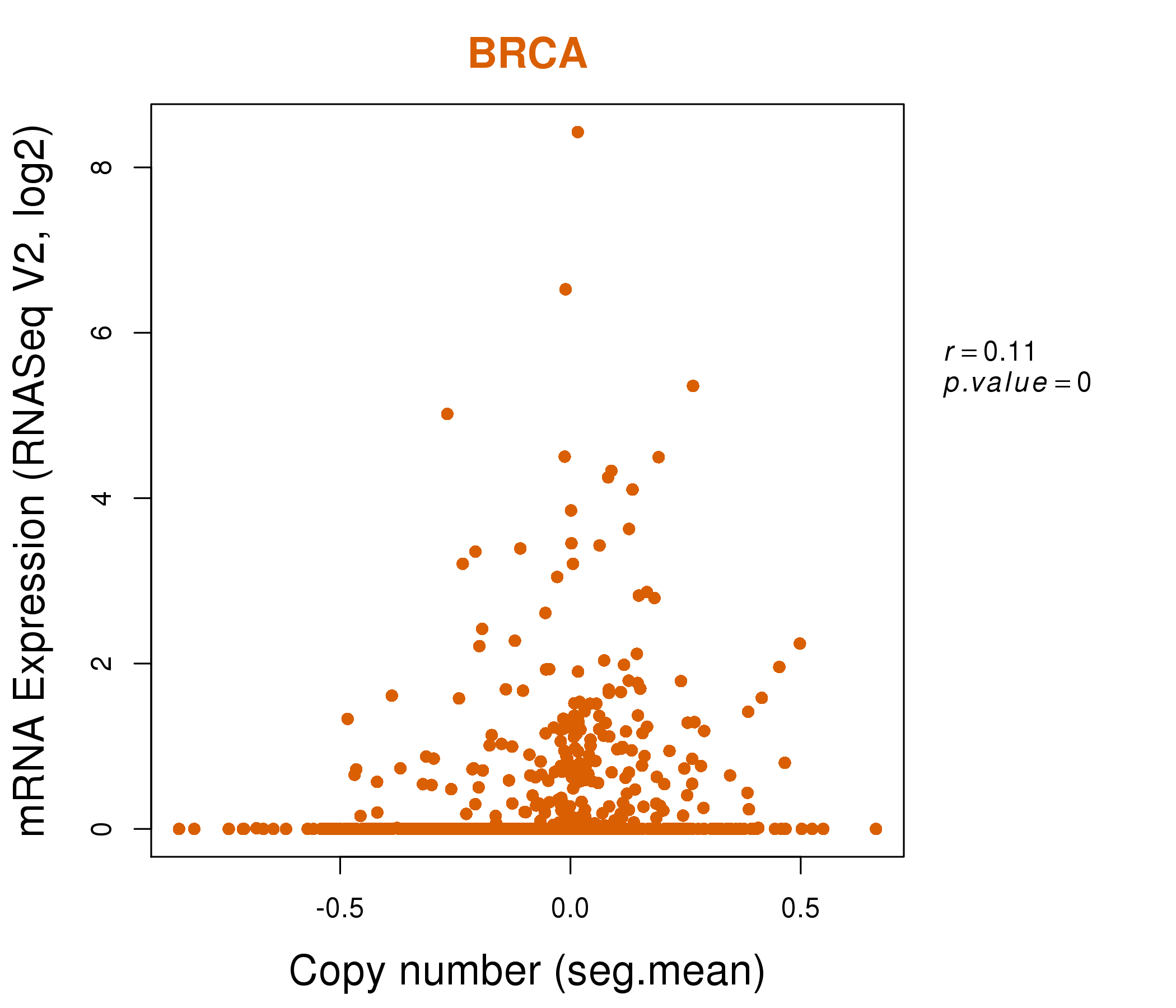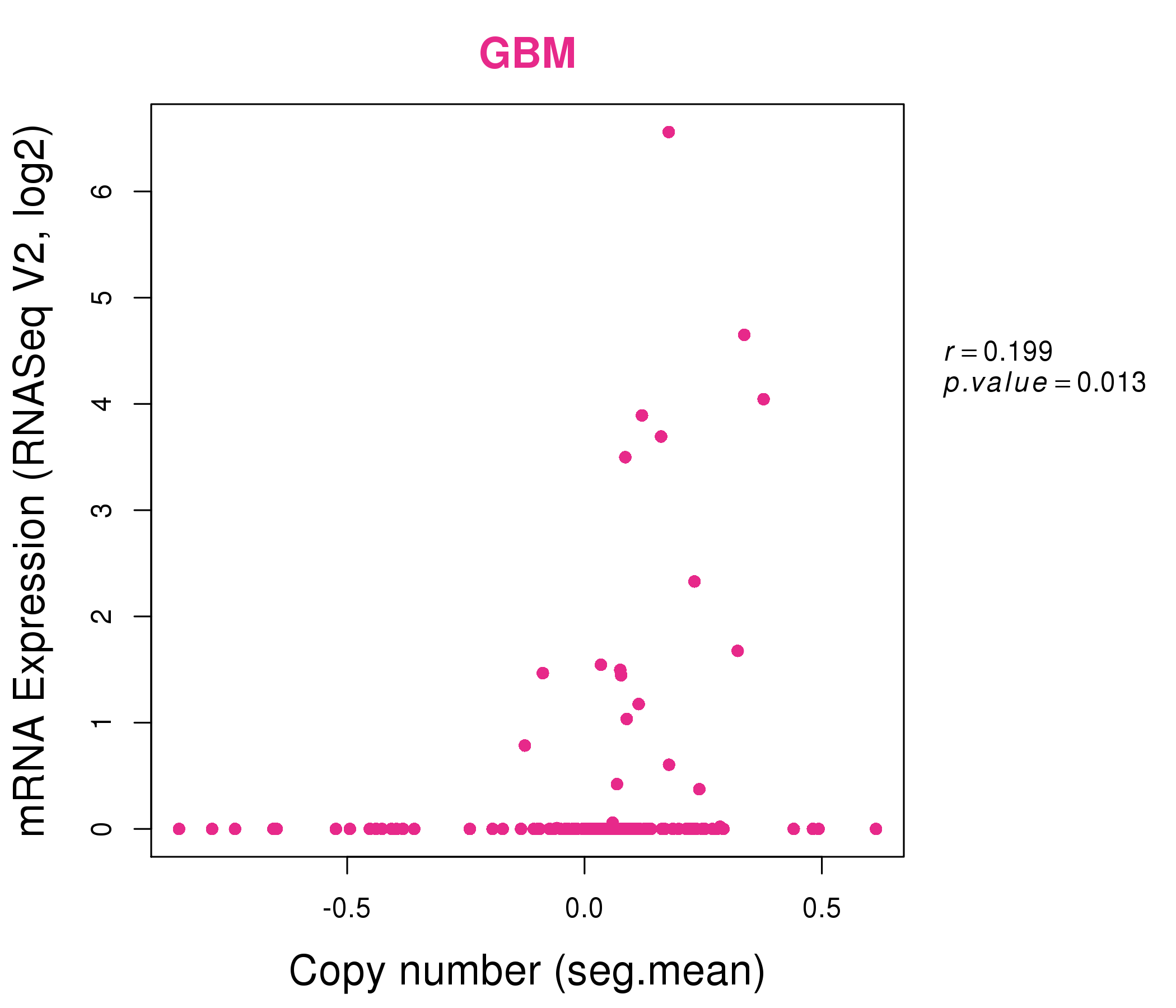|
|||||||||||||||||||||||||||||||||||||||||||||||||||||||||||||||||||||||||||||||||||||||||||||||||||||||||||||||||||||||||||||||||||||||||||||||||||||||||||||||||||||||||||||||||||||||||||||||||||||||||||||||||||||||||||||||||||||||||||||||||||||||||||||||||||||||||||||||||||||||||||||||||||||||||||||||||||||||||||||||||||||||||||||
| |
| Phenotypic Information (metabolism pathway, cancer, disease, phenome) |
| |
| |
| Gene-Gene Network Information: Co-Expression Network, Interacting Genes & KEGG |
| |
|
| Gene Summary for FBP2 |
| Basic gene info. | Gene symbol | FBP2 |
| Gene name | fructose-1,6-bisphosphatase 2 | |
| Synonyms | - | |
| Cytomap | UCSC genome browser: 9q22.3 | |
| Genomic location | chr9 :97321002-97356075 | |
| Type of gene | protein-coding | |
| RefGenes | NM_003837.3, | |
| Ensembl id | ENSG00000130957 | |
| Description | D-fructose-1,6-bisphosphate 1-phosphohydrolase 2FBPase 2fructose-1,6-bisphosphatase isozyme 2hexosediphosphatasemuscle FBPasemuscle fructose-bisphosphatase | |
| Modification date | 20141207 | |
| dbXrefs | MIM : 603027 | |
| HGNC : HGNC | ||
| Ensembl : ENSG00000130957 | ||
| HPRD : 04322 | ||
| Vega : OTTHUMG00000020269 | ||
| Protein | UniProt: go to UniProt's Cross Reference DB Table | |
| Expression | CleanEX: HS_FBP2 | |
| BioGPS: 8789 | ||
| Gene Expression Atlas: ENSG00000130957 | ||
| The Human Protein Atlas: ENSG00000130957 | ||
| Pathway | NCI Pathway Interaction Database: FBP2 | |
| KEGG: FBP2 | ||
| REACTOME: FBP2 | ||
| ConsensusPathDB | ||
| Pathway Commons: FBP2 | ||
| Metabolism | MetaCyc: FBP2 | |
| HUMANCyc: FBP2 | ||
| Regulation | Ensembl's Regulation: ENSG00000130957 | |
| miRBase: chr9 :97,321,002-97,356,075 | ||
| TargetScan: NM_003837 | ||
| cisRED: ENSG00000130957 | ||
| Context | iHOP: FBP2 | |
| cancer metabolism search in PubMed: FBP2 | ||
| UCL Cancer Institute: FBP2 | ||
| Assigned class in ccmGDB | C | |
| Top |
| Phenotypic Information for FBP2(metabolism pathway, cancer, disease, phenome) |
| Cancer | CGAP: FBP2 |
| Familial Cancer Database: FBP2 | |
| * This gene is included in those cancer gene databases. |
|
|
|
|
|
|
| |||||||||||||||||||||||||||||||||||||||||||||||||||||||||||||||||||||||||||||||||||||||||||||||||||||||||||||||||||||||||||||||||||||||||||||||||||||||||||||||||||||||||||||||||||||||||||||||||||||||||||||||||||||||||||||||||||||||||||||||||||||||||||||||||||||||||||||||||||||||||||||||||||||||||||||||||||||||||||||||||||||||
Oncogene 1 | Significant driver gene in | ||||||||||||||||||||||||||||||||||||||||||||||||||||||||||||||||||||||||||||||||||||||||||||||||||||||||||||||||||||||||||||||||||||||||||||||||||||||||||||||||||||||||||||||||||||||||||||||||||||||||||||||||||||||||||||||||||||||||||||||||||||||||||||||||||||||||||||||||||||||||||||||||||||||||||||||||||||||||||||||||||||||||||||
| cf) number; DB name 1 Oncogene; http://nar.oxfordjournals.org/content/35/suppl_1/D721.long, 2 Tumor Suppressor gene; https://bioinfo.uth.edu/TSGene/, 3 Cancer Gene Census; http://www.nature.com/nrc/journal/v4/n3/abs/nrc1299.html, 4 CancerGenes; http://nar.oxfordjournals.org/content/35/suppl_1/D721.long, 5 Network of Cancer Gene; http://ncg.kcl.ac.uk/index.php, 1Therapeutic Vulnerabilities in Cancer; http://cbio.mskcc.org/cancergenomics/statius/ |
| KEGG_GLYCOLYSIS_GLUCONEOGENESIS KEGG_FRUCTOSE_AND_MANNOSE_METABOLISM REACTOME_METABOLISM_OF_CARBOHYDRATES REACTOME_GLUCOSE_METABOLISM | |
| OMIM | |
| Orphanet | |
| Disease | KEGG Disease: FBP2 |
| MedGen: FBP2 (Human Medical Genetics with Condition) | |
| ClinVar: FBP2 | |
| Phenotype | MGI: FBP2 (International Mouse Phenotyping Consortium) |
| PhenomicDB: FBP2 | |
| Mutations for FBP2 |
| * Under tables are showing count per each tissue to give us broad intuition about tissue specific mutation patterns.You can go to the detailed page for each mutation database's web site. |
| There's no structural variation information in COSMIC data for this gene. |
| * From mRNA Sanger sequences, Chitars2.0 arranged chimeric transcripts. This table shows FBP2 related fusion information. |
| ID | Head Gene | Tail Gene | Accession | Gene_a | qStart_a | qEnd_a | Chromosome_a | tStart_a | tEnd_a | Gene_a | qStart_a | qEnd_a | Chromosome_a | tStart_a | tEnd_a |
| Top |
| Mutation type/ Tissue ID | brca | cns | cerv | endome | haematopo | kidn | Lintest | liver | lung | ns | ovary | pancre | prost | skin | stoma | thyro | urina | |||
| Total # sample | 1 | 1 | ||||||||||||||||||
| GAIN (# sample) | ||||||||||||||||||||
| LOSS (# sample) | 1 | 1 |
| cf) Tissue ID; Tissue type (1; Breast, 2; Central_nervous_system, 3; Cervix, 4; Endometrium, 5; Haematopoietic_and_lymphoid_tissue, 6; Kidney, 7; Large_intestine, 8; Liver, 9; Lung, 10; NS, 11; Ovary, 12; Pancreas, 13; Prostate, 14; Skin, 15; Stomach, 16; Thyroid, 17; Urinary_tract) |
| Top |
|
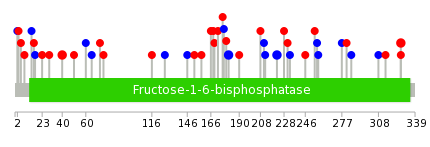 |
| Top |
| Stat. for Non-Synonymous SNVs (# total SNVs=23) | (# total SNVs=14) |
 | 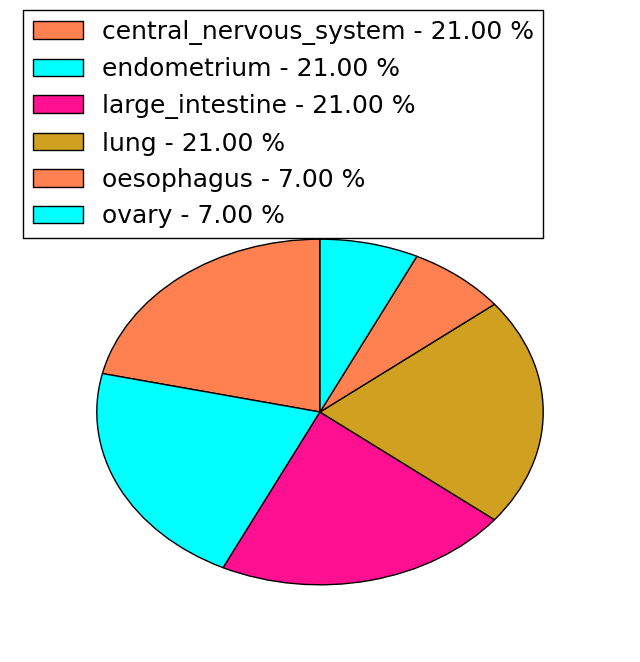 |
(# total SNVs=0) | (# total SNVs=0) |
| Top |
| * When you move the cursor on each content, you can see more deailed mutation information on the Tooltip. Those are primary_site,primary_histology,mutation(aa),pubmedID. |
| GRCh37 position | Mutation(aa) | Unique sampleID count |
| chr9:97321261-97321261 | p.E327* | 3 |
| chr9:97333768-97333768 | p.G181G | 2 |
| chr9:97321259-97321259 | p.E327D | 2 |
| chr9:97329591-97329591 | p.A222A | 2 |
| chr9:97355890-97355890 | p.T40M | 2 |
| chr9:97333873-97333873 | p.D146D | 1 |
| chr9:97355958-97355958 | p.Y17Y | 1 |
| chr9:97325689-97325689 | p.H254Y | 1 |
| chr9:97346904-97346904 | p.I127I | 1 |
| chr9:97355963-97355963 | p.R16C | 1 |
| Top |
|
 |
| Point Mutation/ Tissue ID | 1 | 2 | 3 | 4 | 5 | 6 | 7 | 8 | 9 | 10 | 11 | 12 | 13 | 14 | 15 | 16 | 17 | 18 | 19 | 20 |
| # sample | 8 | 3 | 1 | 3 | 2 | 6 | 4 | 5 | ||||||||||||
| # mutation | 8 | 3 | 1 | 3 | 2 | 6 | 5 | 5 | ||||||||||||
| nonsynonymous SNV | 5 | 1 | 1 | 1 | 1 | 3 | 4 | 2 | ||||||||||||
| synonymous SNV | 3 | 2 | 2 | 1 | 3 | 1 | 3 |
| cf) Tissue ID; Tissue type (1; BLCA[Bladder Urothelial Carcinoma], 2; BRCA[Breast invasive carcinoma], 3; CESC[Cervical squamous cell carcinoma and endocervical adenocarcinoma], 4; COAD[Colon adenocarcinoma], 5; GBM[Glioblastoma multiforme], 6; Glioma Low Grade, 7; HNSC[Head and Neck squamous cell carcinoma], 8; KICH[Kidney Chromophobe], 9; KIRC[Kidney renal clear cell carcinoma], 10; KIRP[Kidney renal papillary cell carcinoma], 11; LAML[Acute Myeloid Leukemia], 12; LUAD[Lung adenocarcinoma], 13; LUSC[Lung squamous cell carcinoma], 14; OV[Ovarian serous cystadenocarcinoma ], 15; PAAD[Pancreatic adenocarcinoma], 16; PRAD[Prostate adenocarcinoma], 17; SKCM[Skin Cutaneous Melanoma], 18:STAD[Stomach adenocarcinoma], 19:THCA[Thyroid carcinoma], 20:UCEC[Uterine Corpus Endometrial Carcinoma]) |
| Top |
| * We represented just top 10 SNVs. When you move the cursor on each content, you can see more deailed mutation information on the Tooltip. Those are primary_site, primary_histology, mutation(aa), pubmedID. |
| Genomic Position | Mutation(aa) | Unique sampleID count |
| chr9:97333768 | p.G181G | 2 |
| chr9:97355963 | p.V285V | 1 |
| chr9:97329621 | p.A166V | 1 |
| chr9:97346868 | p.S5N | 1 |
| chr9:97355969 | p.E281K | 1 |
| chr9:97329624 | p.R158H | 1 |
| chr9:97346904 | p.R277R | 1 |
| chr9:97355987 | p.D146D | 1 |
| chr9:97321299 | p.T256T | 1 |
| chr9:97329633 | p.I139M | 1 |
| * Copy number data were extracted from TCGA using R package TCGA-Assembler. The URLs of all public data files on TCGA DCC data server were gathered on Jan-05-2015. Function ProcessCNAData in TCGA-Assembler package was used to obtain gene-level copy number value which is calculated as the average copy number of the genomic region of a gene. |
 |
| cf) Tissue ID[Tissue type]: BLCA[Bladder Urothelial Carcinoma], BRCA[Breast invasive carcinoma], CESC[Cervical squamous cell carcinoma and endocervical adenocarcinoma], COAD[Colon adenocarcinoma], GBM[Glioblastoma multiforme], Glioma Low Grade, HNSC[Head and Neck squamous cell carcinoma], KICH[Kidney Chromophobe], KIRC[Kidney renal clear cell carcinoma], KIRP[Kidney renal papillary cell carcinoma], LAML[Acute Myeloid Leukemia], LUAD[Lung adenocarcinoma], LUSC[Lung squamous cell carcinoma], OV[Ovarian serous cystadenocarcinoma ], PAAD[Pancreatic adenocarcinoma], PRAD[Prostate adenocarcinoma], SKCM[Skin Cutaneous Melanoma], STAD[Stomach adenocarcinoma], THCA[Thyroid carcinoma], UCEC[Uterine Corpus Endometrial Carcinoma] |
| Top |
| Gene Expression for FBP2 |
| * CCLE gene expression data were extracted from CCLE_Expression_Entrez_2012-10-18.res: Gene-centric RMA-normalized mRNA expression data. |
 |
| * Normalized gene expression data of RNASeqV2 was extracted from TCGA using R package TCGA-Assembler. The URLs of all public data files on TCGA DCC data server were gathered at Jan-05-2015. Only eight cancer types have enough normal control samples for differential expression analysis. (t test, adjusted p<0.05 (using Benjamini-Hochberg FDR)) |
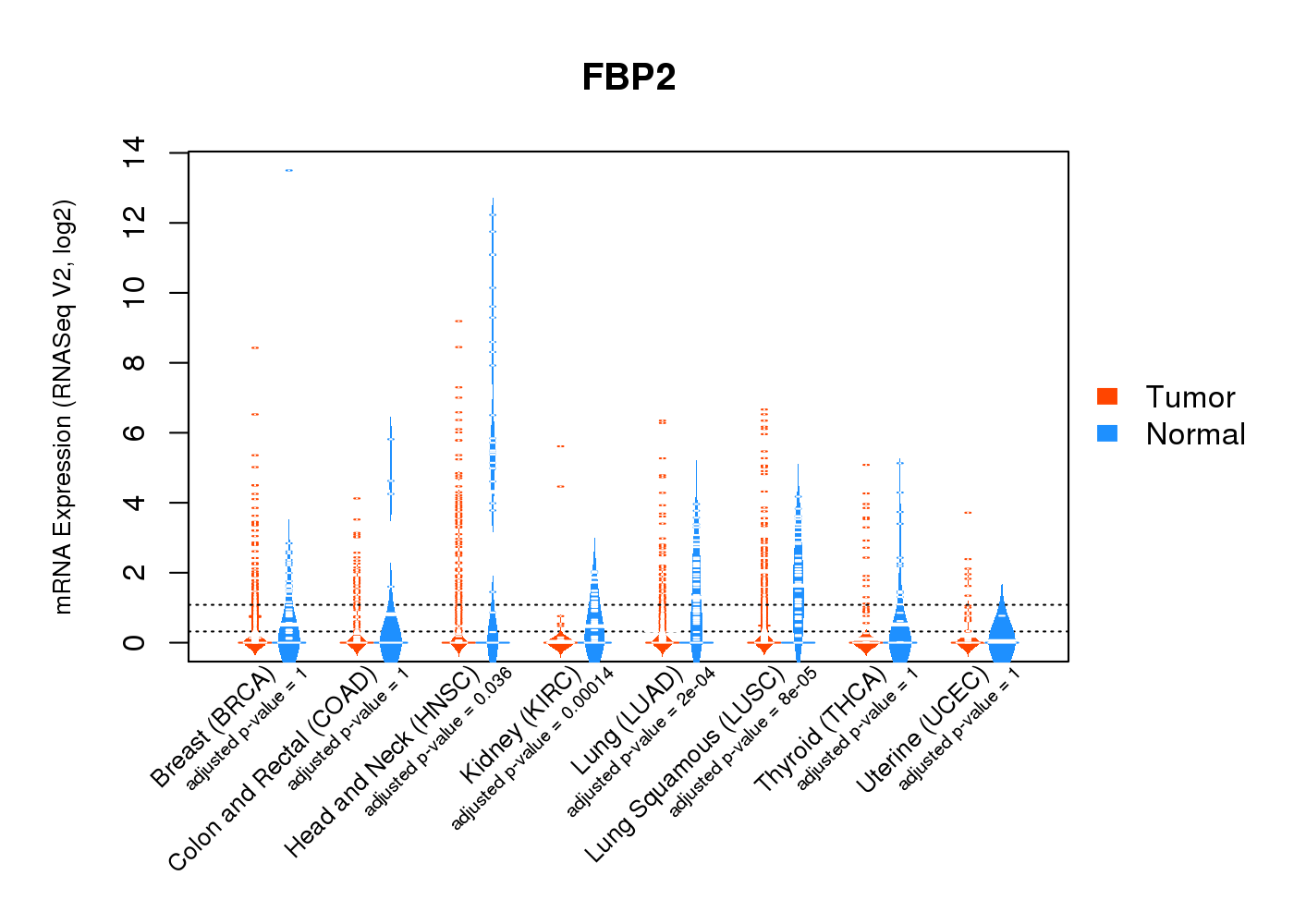 |
| Top |
| * This plots show the correlation between CNV and gene expression. |
: Open all plots for all cancer types
 |
|
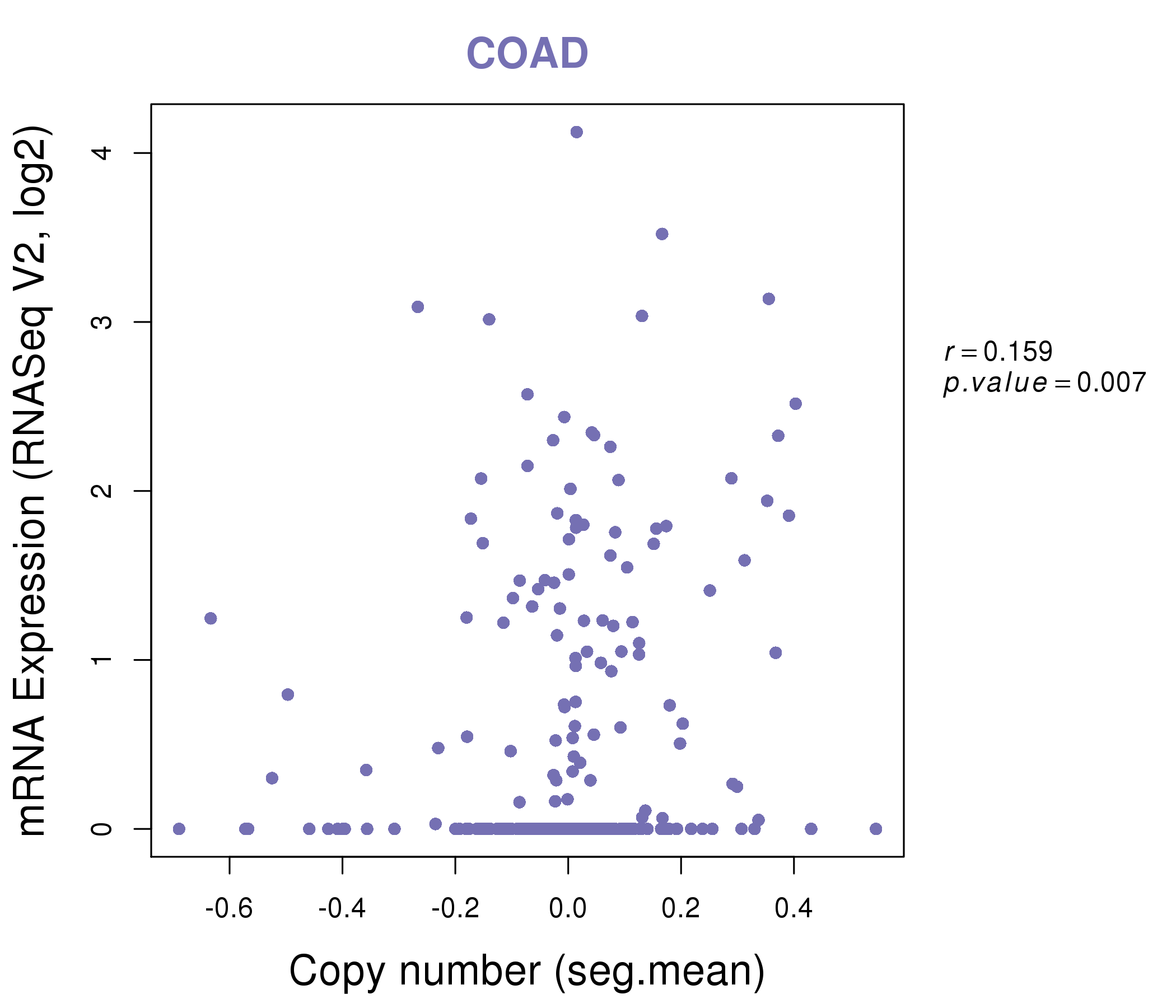 |
|
| Top |
| Gene-Gene Network Information |
| * Co-Expression network figures were drawn using R package igraph. Only the top 20 genes with the highest correlations were shown. Red circle: input gene, orange circle: cell metabolism gene, sky circle: other gene |
: Open all plots for all cancer types
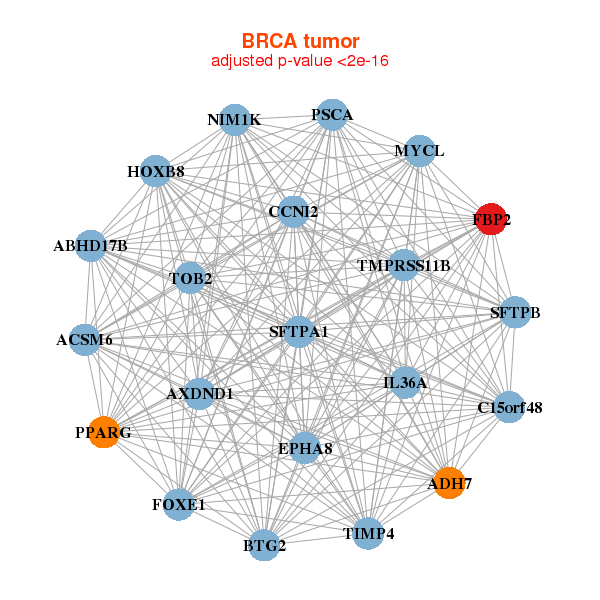 |
| ||||
| ADH7,BTG2,ACSM6,C15orf48,AXDND1,CCNI2,EPHA8, ABHD17B,FBP2,FOXE1,HOXB8,IL36A,NIM1K,MYCL, PPARG,PSCA,SFTPA1,SFTPB,TIMP4,TMPRSS11B,TOB2 | ACTA1,ACTN2,ATP2A1,C10orf71,MIR1-1HG,CACNA1S,CKM, CSRP3,ENO3,FBP2,HFE2,LMOD2,MYH2,MYH6, MYH7,MYL1,MYL2,MYLPF,NRAP,PPP1R3A,TECRL | ||||
 |
| ||||
| ADCY10,ASUN,C12orf71,CASC1,DLK1,FBP2,FGFR1OP2, GPR112,GRK1,KLHL42,KRAS,LYRM5,MED21,MRPS35, NR5A1,PROL1,SLC23A3,STAR,STK38L,TM | GGACT,ARGFX,BPY2,C1orf100,CTRB1,FBP2,FUT5, GJA3,KRT78,LANCL2,LOC723809,MARS2,MMP13,NLRP10, NRG1,OR2T12,OR52M1,PNPLA5,RHO,SYCN,TSGA13 |
| * Co-Expression network figures were drawn using R package igraph. Only the top 20 genes with the highest correlations were shown. Red circle: input gene, orange circle: cell metabolism gene, sky circle: other gene |
: Open all plots for all cancer types
| Top |
: Open all interacting genes' information including KEGG pathway for all interacting genes from DAVID
| Top |
| Pharmacological Information for FBP2 |
| DB Category | DB Name | DB's ID and Url link |
| * Gene Centered Interaction Network. |
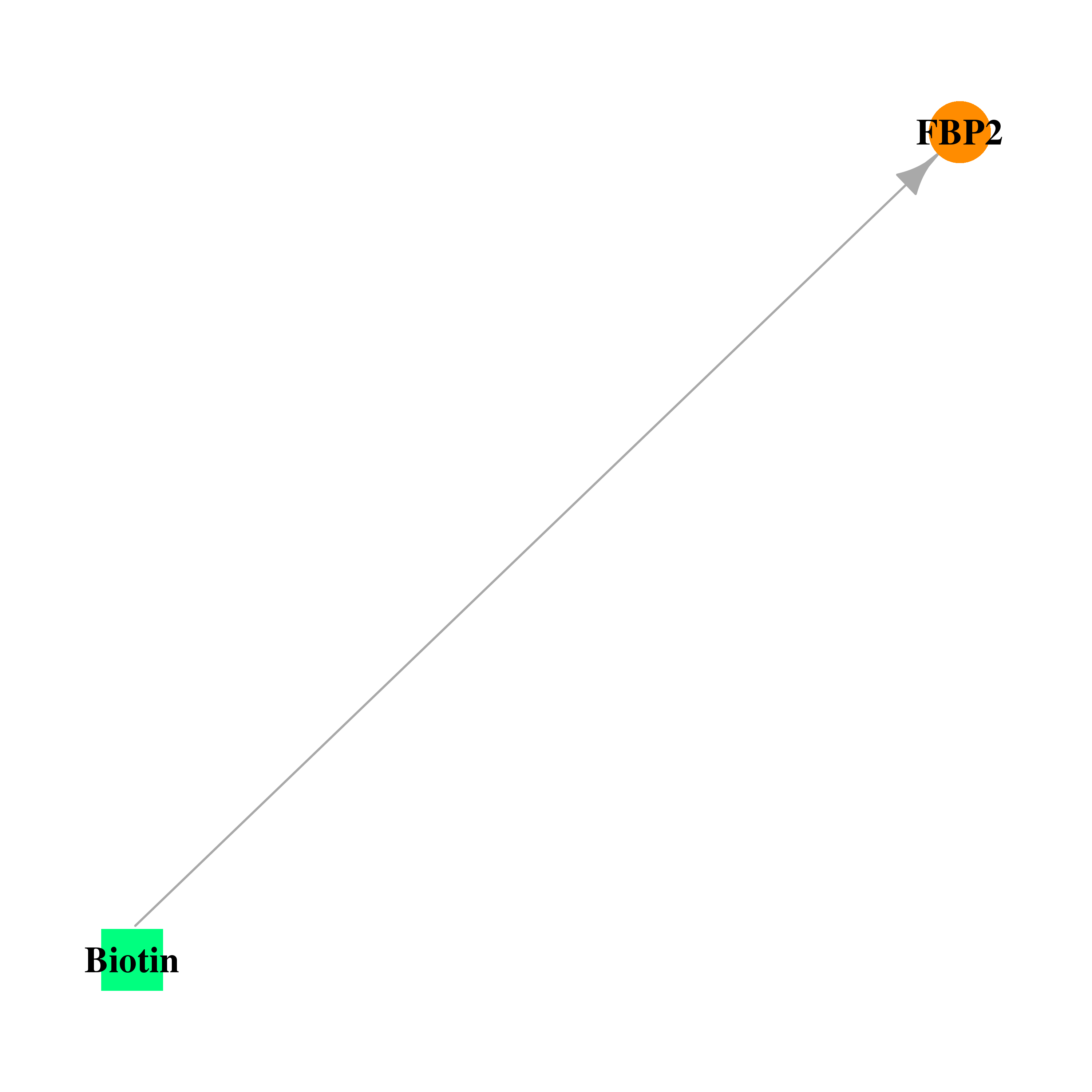 |
| * Drug Centered Interaction Network. |
| DrugBank ID | Target Name | Drug Groups | Generic Name | Drug Centered Network | Drug Structure |
| DB00121 | fructose-1,6-bisphosphatase 2 | approved; nutraceutical | Biotin |  | 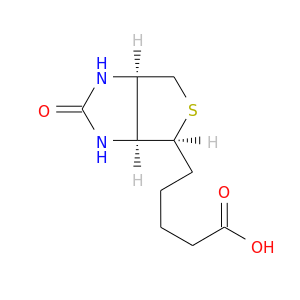 |
| Top |
| Cross referenced IDs for FBP2 |
| * We obtained these cross-references from Uniprot database. It covers 150 different DBs, 18 categories. http://www.uniprot.org/help/cross_references_section |
: Open all cross reference information
|
Copyright © 2016-Present - The Univsersity of Texas Health Science Center at Houston @ |






